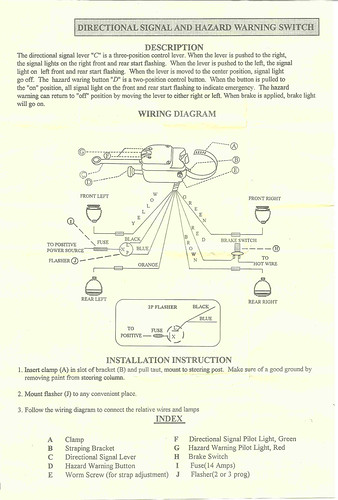
I'm a great believer in reading, understanding, and following instructions. Usually, that works out just fine. There are rare occasions when it doesn't. This is the story of one of those rare occasions.
When I was planning the wiring of the dune buggy, I remembered that my brother had used an aftermarket turn signal switch on the Jeep we used to kick around in when we lived in Idaho Springs, Colorado. That switch was a big, shiny chrome box that attached to the steering column with an adjustable strap. It had a nifty little green light on it that would blink when it was flashing the turn signals. I thought that would be the perfect item for the dune buggy, but it had been quite awhile since our Jeep days. It was the early 70's when my brother had that Jeep and I wondered whether that switch was still being made nearly 30 years later. When I went to the auto parts store in Los Angeles in 1999 when I built my dune buggy, I found that same switch right there on the bottom shelf, nifty little green light and all. Of course, I bought it.
In the picture above, you can see the wiring diagram and instructions for installing this marvelous little device. It's really a shame that this wonderfully simply diagram is completely wrong. I carefully following the diagram and connected all the wires as indicated. When I switched on the power, nothing worked. Lights were not flashing. I check the diagram. I traced all the wires to make sure I had it right. It just wasn't working. As I said, the wiring diagram was wrong in every way. The colors of the wires just didn't correspond to the functions of the switch.
Anyone else probably would have taken it back to the store and demanded a replacement. For some reason, I don't do things that way. First of all, I knew that there wasn't another switch in the store. I had purchased the only one they had. Second, I wasn't going to let some simple little switch keep me from getting my turn signals working, so I took it apart, got out my continuity tester and started tracing circuits. Eventually, I figured out which circuit was the right side and which was the left. I reconnected all the wires to the correct circuits, powered up the vehicle and it actually worked. It's worked just fine throughout the entire the ten years since I fixed it. It really is a good switch, I guess whoever was working on the assembly line the day it was built was hung-over, drugged or asleep.
The moral of the story is that, as good an idea as carefully reading and following instructions is, sometimes it's just not enough. Sometimes you just have to dig in and figure things out for yourself. When you've done that, when you've taken things apart and figured out how they work, then you really get a fundamental understanding of what is happening when you turn the ignition switch, start the engine, and pull away from the curb. Fundamentals are especially important when something doesn't work, because if you know your fundamentals you can more easily isolate, diagnose and correct the problem. Without fundamentals you waste a lot of time fixing things that aren't broken.




No comments:
Post a Comment